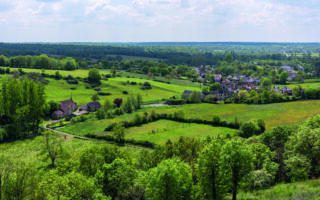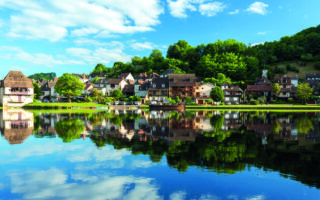Dealing with Damp in the Dordogne
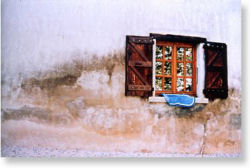

A Problem Rarely Understood
The town square in front of our house slopes gently down to where a stream flows underground. Under the slightly raised ground floor there is a cellar with open vents to the pavement outside, providing ventilation – and draughts in the winter. The cellar didn’t smell of damp when we bought it – just a bit musty. The only damp observed by our surveyor was one small stain in a corner of the back hall. We knew that local houses didn’t have damp courses, so weren’t particularly surprised.
We wanted to reorganise the rooms in the house, simplifying the overall layout. So builders were organised, and began work. And, as builders do, they began to strip things off the wall.
That was how we got to learn about damp.
Contributions from Neighbours
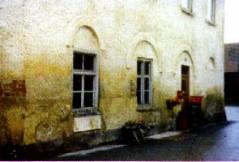
Damp stains at ground floor level
We had almost every possible variety of damp, it turned out. Part of it came from our neighbours. They had, some time before, connected their first floor shower outlet to the rainwater downpipe. The soapy water had eroded the pipe. During each of the four daily showers taken by the household the water cascaded over the cut stone of our back wall. In the front of the house, another downpipe was blocked. Rainwater flowed out of a joint and down into our cellar.
Our neighbours were charming, and that was easily remedied.
Rising Damp
Less easy was the rising damp diagnosed in all the downstairs walls. This appeared when the wallcoverings were removed. The problem was twofold. First, water was seeping up. Secondly, it couldn’t evaporate out of the walls because the walls were covered. In some cases it was just a plasterboard casing over recesses. But there was also nineteenth century wood panelling up to waist height, and foambacked wallpaper. Elsewhere the walls had been covered with a cement render.
From our renovation experience in the UK we had always understood that damp rose up to about waist height, which is why walls always needed replastering up to this height after installation of a damp course. We discovered, however, that this is not the case in the Dordogne.
Basically, the lesson is: forget everything you thought you knew about rising damp.
The Reason for Rising Damp
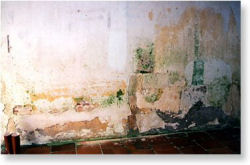
Damp on interior wall
Why does damp rise in the first place? The contact of underground water with the various materials below the house and in the walls creates an electromagnetic field. This gives rise to a magnetic force that draws the water up the materials in the walls. You may have a distant recollection of what happens with iron filings when placed near a magnet. I can only say it’s something like that.
The solution, provided by a company called Mur-Tronic, is to reverse the direction of the magnetic force, so that the water is pushed down instead of being drawn up. This removes the problem of the damp coming up.
How is this achieved? By the installation of a piece of patented equipment, which emits some sort of frequency that does the trick. Don’t ask me to be more technical than that. It sounds like mumbo-jumbo, but it does actually work. It stays in the house for life.
Drying out the Walls
That of course then leaves you with the problem of drying the walls out and allowing them to breathe. Off come all those “cache-misères” – the coverings that conceal all the structural problems. Any cement render has to be removed. The walls are then coated in a lime-based render. They can’t be wallpapered, and have to be painted in a lime-based paint.
Needless to say, where damp has seeped into cut stone for years it may take a considerable time to dry out. However, we have been astonished by the visible changes of colour in the mortar as the walls dry out.
A Happy Ending
It’s been a relief to find that we don’t have to live in a house with dripping walls, hidden behind layers of plasterboard. Like so many other things in the Dordogne, we’ve had to abandon preconceived notions and understand that things are different here.
One incidental benefit is that we’ve been told the effect of all this electromagnetic reversal is a charge of positive ions that gives the house a happy atmosphere. All in all, enough to put a smile on your face!
Antony Mair
All photos are courtesy of Mur-Tronic
Share to: Facebook Twitter LinkedIn Email
More in courses, dordogne, learning, renovation, work
By FrenchEntrée
Leave a reply
Your email address will not be published. Required fields are marked *

